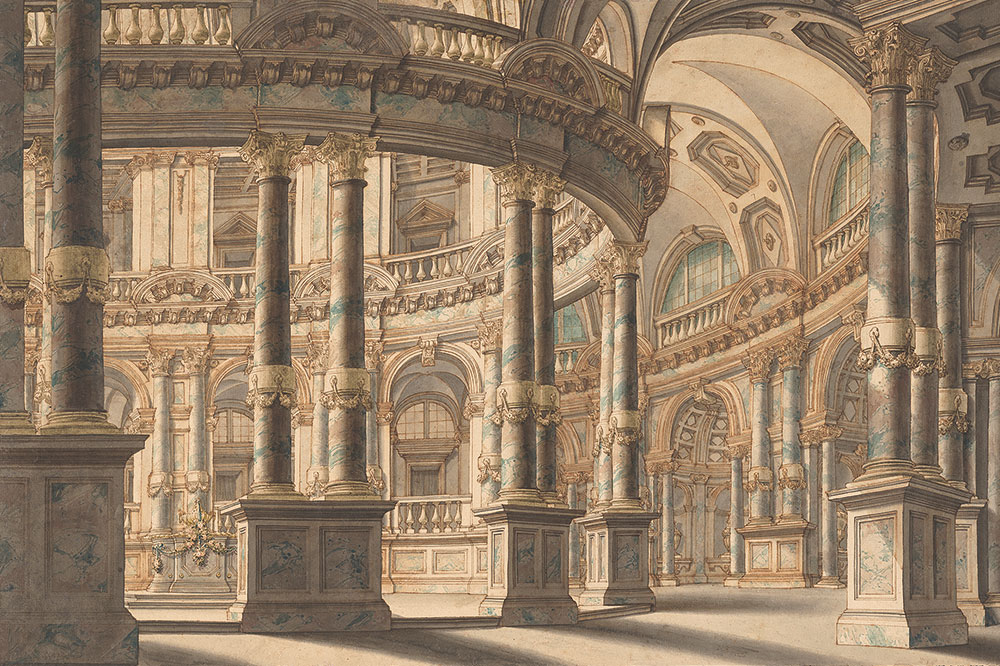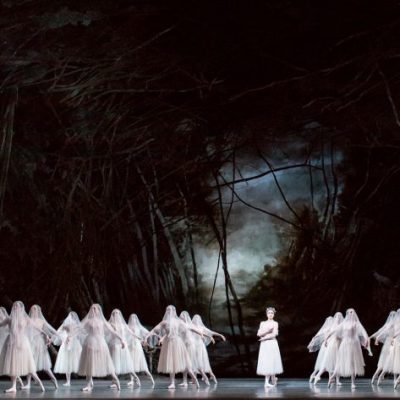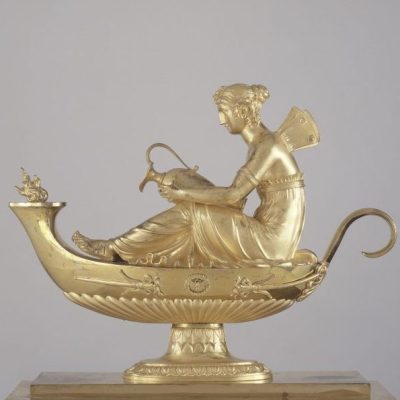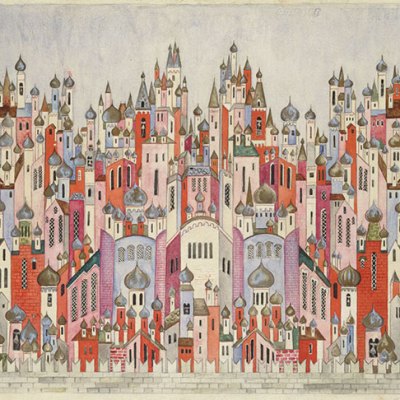The Bibienas, an Italian dynasty of designers active from the 1680s into the early 1800s, made public spectacles possible all over Europe, from Lisbon to St Petersburg. Four generations of the family helped courts and impresarios put on operas and entertainments that flaunted the power, wealth and sophistication of the entrepreneurs and regimes that backed them, as backstage crews wheeled and pulleyed the Bibienas’ overlapping flat panels in order to create illusions of infinite depth. ‘Nothing of the kind was ever more magnificent,’ wrote Lady Mary Wortley Montagu to her friend Alexander Pope in 1716, after watching an imperial opera that the Bibienas staged outdoors in Vienna. Crowds jostled to catch glimpses of a naval armada in gold, on a mission to rescue prisoners from a sorceress’s lair.
The family, originally from the Tuscan town of Bibbiena, had its headquarters in Bologna and specialised in creating oblique views of baroque courtyards, arcades, balconies and stairwells for stage sets. It also gamely took on assignments from theatres for twilit waterfronts, weedy ruins, islands crawling with monsters and dank prisons. Statues along balustrades and niches were depicted preening scornfully or carrying weapons. Clusters of urns and ornate columns provided hideaways for eavesdropping schemers, suitors, martyrs or prey, as the plots required.
The timing of this small but transporting exhibition of 26 drawings and an album, acquired by the lighting designer Jules Fisher (who is donating 25 drawings to the museum), is perfect. So many theatres have been dark for so long that I struggle to remember what it was like to splurge on Broadway seats and be part of an audience shivering with anticipation as curtains rise on immersive sets that simulate vistas. Or, as the curator John Marciari puts it, summing up aspects of the Covid experience, ‘We’re all sick of our own four walls.’
Three-Storey Atrium with Caryatids (c. 1730–50), attributed to Giuseppe Galli Bibiena. Promised gift of Jules Fisher to the Morgan Library & Museum, New York.
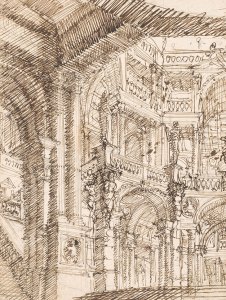
The artworks on view range from rough ink sketches, with dense zigzags suggesting archways in shadow, to polished renderings with watercolour strokes creating glimpses of sky and striated marble pillars. The Bibiena sets depicted in this exhibition were mostly meant to be adaptable for multiple productions. But there is also a harbour scene from the 1710s, in which ships bristle with rigging, pennants and lanterns – the tableau was lit from behind while some star-crossed lovers reunited at the end of the opera La Cunegonda, to the strains of a score by Antonio Vivaldi.
Courtyard of a Palace, a Design for the Stage (c. 1710–20), Giuseppe Galli Bibiena. Promised gift of Jules Fisher to the Morgan Library & Museum, New York

The Bibienas were also tireless designers of trompe-l’oeil frescoes, catafalques crowned in obelisks, and actual buildings: among their best-known surviving theatres and churches are the Margravial Opera House in Bayreuth, the Jesuit Church in Mannheim and the Teatro Bibiena in Mantua. Members of the family travelled together and collaborated so closely, and confusingly, that scholars have changed attributions for some drawings multiple times over the years. The founding generation, Ferdinando (1657–1743) and his brother Francesco (1659–1739), had numerous offspring who joined the business, some with distinctive styles and handwriting. Their many assistants, protégés and imitators are known as Bibieneschi. The lineage died out with Ferdinando’s great-grandson Filippo (1765–1842), whose paintings and ornaments survive in a few interiors including the frothily tiered Teatro Feronia in San Severino Marche.
Along the margins of the working documents, the Bibienas and Bibieneschi inscribed now-inscrutable codes of numbers and letters, which guided the stage builders. Some designs were apparently edited in a hurry. On one view of a colonnaded interior, from around 1750, someone has used a different shade of ink to suggest floral festoons spiralling down the fluted columns and dangling from the beams and archways. In the lower-right corner, two scraps of tacked-on paper depict disembodied hoofs, marking where a silhouette of some creature was proposed and then torn away (Fig. 3). How methodical and pragmatic the Bibiena teams were, labouring over their ephemeral dream-worlds, creating what the theatre historian Arnold Aronson describes in one of the catalogue essays as ‘a passage into a magnificent parallel reality’.
A Colonnaded Stage (c. 1750), Carlo Galli Bibiena. Promised gift of Jules Fisher to the Morgan Library & Museum, New York
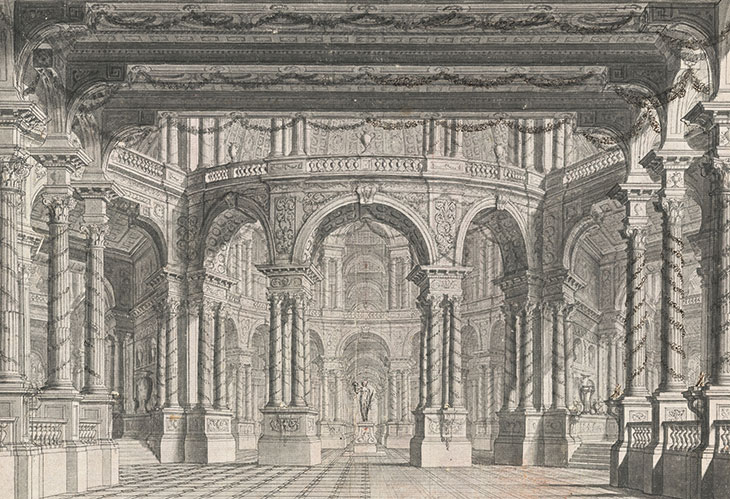
The catalogue provides provenance trails as well and Fisher, an octogenarian, has kept buying. Nosy museum-goers like me, once informed of his auction sources, can check online for records of the prices paid. In January 2015, he successfully bid $3,000 at Christie’s in New York for an ink drawing of a Piranesian courtyard where a downcast bust occupies a niche over a child playing with a dog alongside an adult couple – plotters? betrotheds? – deep in conversation. A few months later, Fisher bid €3,500 at Christie’s in Paris for a ceiling decoration proposal with plump helical columns that look expertly squeezed out of cake-frosting nozzles.
Marciari’s catalogue essay discusses previous enthusiasts for this collecting niche. Some clusters of works remained in the hands of the original patrons, including the Habsburgs. In the 20th century, many collectors, like Fisher, have been active in the performance and design worlds. Their ranks have included the set designer Donald Oenslager (the Morgan owns much of his Bibiena holdings); the Hungarian-born cellist Janos Scholz; the Swiss architect Edmond Fatio; and the Italian painter, architect and curator Giovanni Piancastelli. (The philanthropist Peter May is among current fans. A new book of his collection of architectural drawings, also published by Paul Holberton, includes a Bibiena-attributed set design with an intimidatingly monumental palace facade and obelisk-topped bridge.)
The drawings circulating on the market have typically been stored in albums (glue residue remains at some corners). Fisher has lent the Morgan an intact album with 113 artworks. For the current show, it has been opened to a study for a proscenium arch. The asymmetrical confection would have revealed to clients a wide array of available options. Pediment scrollwork could be concave or convex, resting on Ionic pilasters facing front or torqued sideways, and cartouches could have boxy or rounded outlines. Figures of goddesses and cherubs perch along the protruding mouldings. They seem comfortably settled in for rollicking evenings of entertainment in the footlights.
‘Architecture, Theater, and Fantasy: Bibiena Drawings from the Jules Fischer Collection’ is at the Morgan Library & Museum, New York, until 12 September.
